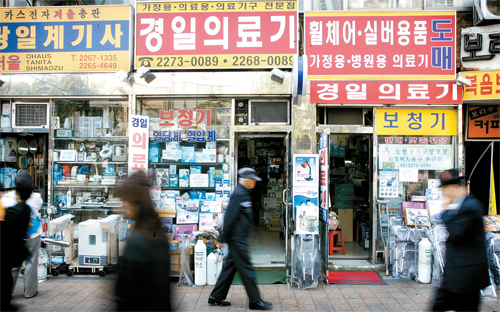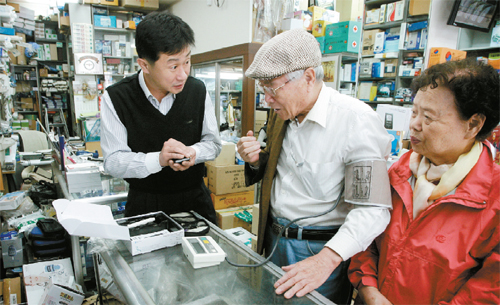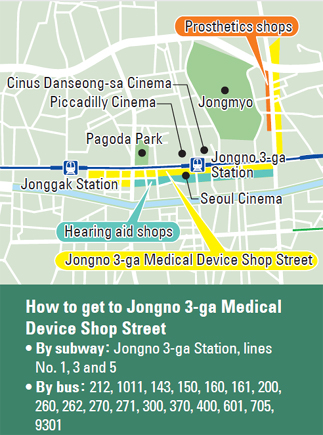Health care devices for all of your medical needs

Pedestrians walk through Jongno 3-ga Medical Device Street, the largest area for such devices in the country. Around 70 to 80 medical device shops line the streets of Jongno 2-ga, 3-ga and 4-ga, but most are located in Jongno 3-ga. By Oh Sang-min
During the Joseon Dynasty (1392-1910), the government formed a cluster of more than 2,000 shops that lined the streets of Jongno and spilled over into the neighboring Gwanghwamun, Namdaemun and Seodaemun areas. The market sold all kinds of items, but it became known for six items in particular - silk, raw silk, paper, fish, ramie fabric and cotton. These items gave the market its nickname of yukeuijeon, or “six-item street.”
Although Jongno’s reputation as a heavily trafficked market has survived over time, the six items have changed, with the old best-sellers giving way to more modern inventions. Today, medical devices are among the most sought-after items in the marketplace.
There are around 70 to 80 medical device shops in Jongno, particularly at Jongno 3-ga. This forms the largest cluster of such shops in the country, according to the Korea Medical Device Sales Association.
“Some of the shops that opened as early as 1967 are now closed, but there are others coming in,” said Kim Hyee-gyoo, the head of the Seoul branch of the KMDSA. Kim also runs the Kyung Il Medical Device Shop in Jongno. “That makes medical device shops some of the most visible shops in Jongno,” he said.
Other shops in the area sell food, jewelry, lighting, stationery and clothing - what Kim says are the new yukeuijeon items, along with medical devices.
In the past, the medical device shops sold a variety of products for home and hospital use and their clientele ranged from individual buyers to hospital industry representatives. But with the advent of large, state-of-the-art machines capable of scanning every part of the body, it is impossible for the shops to meet the demands of large hospitals and health care centers.
These days, the medical device shops focus mostly on home health care devices such as wheelchairs, beds and small instruments for monitoring health at home.
Kim, the KMDSA executive, said that the medical device shops had opened in Jongno in part because of the neighborhood’s proximity to large hospitals such as Seoul National University Hospital.
That location is still an advantage and helps keep the shops in business. Jongno is also highly accessible, with three subway lines and multiple bus lines feeding the neighborhood.
Son Jae-myeong, 60, was one of the shoppers in the area on Saturday. He had stopped by Kyung Sung Medical Device Shop to buy a simple home care device.
He told the manger of the shop, Kim Jae-yeon, 39, that he wanted to be able to check his blood sugar because he was concerned about his diabetes.

An employee at a medical device shop in Jongno, central Seoul, demonstrates a blood-pressure testing device for an elderly couple yesterday.
“Your blood sugar is 140,” Kim told Son. “It should be less than 100.” Kim added that figures over 160 indicate a need for hospitalization.
Son bought the device, but looked a little green as he walked out the door.
“Maybe this will motivate me to eat fewer sweets,” he said.
In recent years, the neighborhood has seen an increase in the number of hearing device shops and prostheses shops.
There are around 15 hearing aid shops in the area, mainly at Jongno 3-ga.
Lee Joung-suk, 40, is an audiologist and co-owner of Sorisem, one of the hearing aid shops. She said that more hearing aid shops are opening in the area based on the positive outlook for the industry.
According to the National Statistical Office, around 10 percent of the population suffered hearing difficulties last year, marking a rapid increase from 6 percent five years earlier.
“In some Western countries, becoming an audiologist is even more difficult than becoming an otolaryngologist [ear, nose and throat specialist],” said Lee. “I believe Korea will eventually go in that direction.”
Another mainstay of the neighborhood is the prosthetics industry. Shops that sell prostheses have been in business in the neighborhood for decades.

All in all, business here has been relatively secure over the years, but the medical device street is now facing fierce competition from online shopping malls and medical supply companies.
That is a growing source of concern among all the merchants in the area, said Kim, the KMDSA executive, but he finds solace in the fact that there will always be a demand for health care products.
“We were not as affected by the economic crisis as other industries,” Kim said. “Jongno medical device street has had a longstanding reputation, and we will try not to lose it.”
By Moon Gwang-lip [joe@joongang.co.kr]










with the Korea JoongAng Daily
To write comments, please log in to one of the accounts.
Standards Board Policy (0/250자)